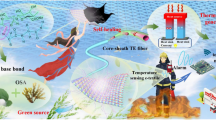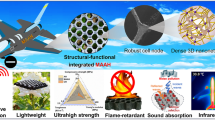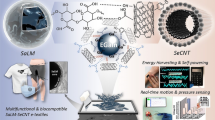Abstract
Most current research on nanocomposites has focused on their bulk attributes, i.e., electrical, microwave, thermal, and mechanical properties. In practical applications, surface properties such as robustness against environmental contamination are critical design considerations if intrinsic properties are to be maintained. The aim of this research is to combine the bulk properties of nanocomposites with the superhydrophobic surface properties provided by imprinting techniques to create a single multi-functional system with enhanced bulk properties. We report the development of a highly conductive superhydrophobic nanotube composite, which is directly superimposed with a durable dual hole pattern through imprinting techniques. The dual hole pattern avoids the use of high slenderness ratio structures resulting in a surface which is robust against physical damage. Its stable superhydrophobic properties were characterized both theoretically and experimentally. By incorporating high aspect ratio carbon nanotubes (CNTs), the dual patterned composites can also be effectively used for anti-icing and deicing applications where their superhydrophobic surface suppresses ice formation and their quick electric heating response at low voltage eliminates remaining frost. In addition, superior electromagnetic interference (EMI) shielding effectiveness (SE) was attained, with one of the highest values ever reported in the literature.

Similar content being viewed by others
References
Chung, D. D. L. Electromagnetic interference shielding effectiveness of carbon materials. Carbon 2001, 39, 279–285.
Bigg, D. M.; Stutz, D. E. Plastic composites for electromagnetic interference shielding applications. Polym. Compos. 1983, 4, 40–46.
Peng, M.; Liao, Z. J.; Qi, J.; Zhou, Z. Nonaligned carbon nanotubes partially embedded in polymer matrixes: A novel route to superhydrophobic conductive surfaces. Langmuir 2010, 26, 13572–13578
Liu, Z. F.; Bai, G.; Huang, Y.; Li, F. F.; Ma, Y. F.; Guo, T. Y.; He, X. B.; Lin, X.; Gao, H. J.; Chen, Y. S. Microwave absorption of single-walled carbon nanotubes/soluble cross-linked polyurethane composites. J. Phys. Chem. C 2007, 111, 13696–13700.
Breuer, O.; Sundararaj, U. Big returns from small fibers: A review of polymer/carbon nanotube composites. Polym. Compos. 2004, 25, 630–645.
Peigney, A.; Laurent, C.; Flahaut, E.; Bacsa, R. R.; Rousset, A. Specific surface area of carbon nanotubes and bundles of carbon nanotubes. Carbon 2001, 39, 507–514.
Park, S. H.; Bandaru, P. R. Improved mechanical properties of carbon nanotube/polymer composites through the use of carboxyl-epoxide functional group linkages. Polymer 2010, 51, 5071–5077.
Park, S. H.; Thielemann, P.; Asbeck, P.; Bandaru, P. R. Enhanced dielectric constants and shielding effectiveness of, uniformly dispersed, functionalized carbon nanotube composites. Appl. Phys. Lett. 2009, 94, 243111.
Sohn, Y.; Lee, S.; Kim, D.; Chu, K.; Kim, D.; Kim, H.; Han, I. Low temperature reliability of carbon nanotube/silicone superhydrophobic coatings. In Proceedings of the 44th International Symposium on Microelectronices (IMAPS 2011), Long Beach, USA, 2011, pp 857–860.
Tang, N. J.; Yang, Y.; Lin, K. J.; Zhong, W.; Au, C. T.; Du, Y. W. Synthesis of plait-like carbon nanocoils in ultrahigh yield, and their microwave absorption properties. J. Phys. Chem. C 2008, 112, 10061–10067.
Neinhuis, C.; Barthlott, W. Characterization and distribution of water-repellent, self-cleaning plant surfaces. Ann. Bot. 1997, 79, 667–677.
Erbil, H. Y.; Demirel, A. L.; Avci, Y.; Mert, O. Transformation of a simple plastic into a superhydrophobic surface. Science 2003, 299, 1377–1380.
Nakajima, A.; Fujishima, A.; Hashimoto, K.; Watanabe, T. Preparation of transparent superhydrophobic boehmite and silica films by sublimation of aluminum acetylacetonate. Adv. Mater. 1999, 11, 1365–1368.
Sun, T. L.; Tan, H.; Han, D.; Fu, Q.; Jiang, L. No platelet can adhere-largely improved blood compatibility on nanostructured superhydrophobic surfaces. Small 2005, 1, 959–963.
Furstner, R.; Barthlott, W.; Neinhuis, C.; Walzel, P. Wetting and self-cleaning properties of artificial superhydrophobic surfaces. Langmuir 2005, 21, 956–961.
Takei, G.; Nonogi, M.; Hibara, A.; Kitamori, T.; Kim, H. B. Tuning microchannel wettability and fabrication of multiple-step laplace valves. Lab Chip 2007, 7, 596–602.
Feng, L.; Li, S. H.; Li, Y. S.; Li, H. J.; Zhang, L. J.; Zhai, J.; Song, Y. L.; Liu, B. Q.; Jiang, L.; Zhu, D. B. Super-hydrophobic surfaces: From natural to artificial. Adv. Mater. 2002, 14, 1857–1860.
Krupenkin, T. N.; Taylor, J. A.; Schneider, T. M.; Yang, S. From rolling ball to complete wetting: The dynamic tuning of liquids on nanostructured surfaces. Langmuir 2004, 20, 3824–3827.
Zhu, L. B.; Xiu, Y. H.; Xu, J. W.; Tamirisa, P. A.; Hess, D. W.; Wong, C. P. Superhydrophobicity on two-tier rough surfaces fabricated by controlled growth of aligned carbon nanotube arrays coated with fluorocarbon. Langmuir 2005, 21, 11208–11212.
Zhang, L.; Resasco, D. E. Single-walled carbon nanotube pillars: A superhydrophobic surface. Langmuir 2009, 25, 4792–4798.
Zou, J. H.; Chen, H.; Chunder, A.; Yu, Y. X.; Huo, Q.; Zhai, L. Preparation of a superhydrophobic and conductive nanocomposite coating from a carbon-nanotube-conjugated block copolymer dispersion. Adv. Mater. 2008, 20, 3337–3341.
Liu, B.; He, Y. N.; Fan, Y.; Wang, X. G. Fabricating super-hydrophobic lotus-leaf-like surfaces through soft-lithographic imprinting. Macromol. Rapid Commun. 2006, 27, 1859–1864.
Cassie, A. B. D.; Baxter, S. Wettability of porous surfaces. Trans. Faraday Soc. 1944, 40, 546–551
Johnson, R. E.; Dettre, R. H. Contact angle hysteresis. In Contact Angle, Wettability, and Adhesion. Fowkes, F. M., Ed.; American Chemical Society: Washington, D. C., 1964; pp 112–135.
Rosca, I. D.; Hoa, S. V. Highly conductive multiwall carbon nanotube and epoxy composites produced by three-roll milling. Carbon 2009, 47, 1958–1968.
Avedisian, C. T.; Cavicchi, R. E.; McEuen, P. M.; Zhou, X. J.; Hurst, W. S.; Hodges, J. T. High temperature electrical resistance of substrate-supported single walled carbon nanotubes. Appl. Phys. Lett. 2008, 93, 252108.
Hewitt, C. A.; Kaiser, A. B.; Roth, S.; Craps, M.; Czerw, R.; Carroll, D. L. Varying the concentration of single walled carbon nanotubes in thin film polymer composites, and its effect on thermoelectric power. Appl. Phys. Lett. 2011, 98, 183110.
Neitzert, H. C.; Vertuccio, L.; Sorrentino, A. Epoxy/MWCNT composite as temperature sensor and electrical heating element. IEEE Trans. Nanotechnol. 2011, 10, 688–693.
Pozar, D. M. Microwave engineering; John Wiley & Sons, Inc.: Hoboken, 1998.
Huang, Y.; Li, N.; Ma, Y. F.; Du, F.; Li, F. F.; He, X. B.; Lin, X.; Gao, H. J.; Chen, Y. S. The influence of single-walled carbon nanotube structure on the electromagnetic interference shielding efficiency of its epoxy composites. Carbon 2007, 45, 1614–1621.
Das, N. C.; Maiti, S. Electromagnetic interference shielding of carbon nanotube/ethylene vinyl acetate composites. J. Mater. Sci. 2008, 43, 1920–1925.
Park, S. H.; Theilmann, P. T.; Asbeck, P. M.; Bandaru, P. R. Enhanced electromagnetic interference shielding through the use of functionalized carbon-nanotube-reactive polymer composites. IEEE Trans. Nanotechnol. 2010, 9, 464–469.
Kim, H. M.; Kim, K.; Lee, C. Y.; Joo, J.; Cho, S. J.; Yoon, H. S.; Pejakovic, D. A.; Yoo, J. W.; Epstein, A. J. Electrical conductivity and electromagnetic interference shielding of multiwalled carbon nanotube composites containing Fe catalyst. Appl. Phys. Lett. 2004, 84, 589–591.
Morgan, S. P. Effects of surface roughness on eddy current losses at microwave frequencies. J. Appl. Phys. 1949, 20, 352–362.
Tsang, L.; Gli, X. X.; Braunisch, H. Effects of random rough surface on absorption by conductors at microwave frequencies. IEEE Microw. Wirel. Compon. Lett. 2006, 16, 221–223.
Author information
Authors and Affiliations
Corresponding authors
Additional information
These authors contributed equally to this work
Electronic supplementary material
Rights and permissions
About this article
Cite this article
Park, SH., Cho, EH., Sohn, J. et al. Design of multi-functional dual hole patterned carbon nanotube composites with superhydrophobicity and durability. Nano Res. 6, 389–398 (2013). https://doi.org/10.1007/s12274-013-0316-8
Received:
Revised:
Accepted:
Published:
Issue Date:
DOI: https://doi.org/10.1007/s12274-013-0316-8




